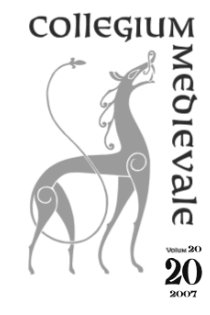Sammendrag
Ole Egil Eide criticises some of our conclusions in the book Utstein Kloster - og Klosterøys historie in Collegium Medievale vol.19:that Utstein Abbey was founded in the 1160s, not in the 1260s as has hitherto been assumed; that Utstein Abbey has a first building phase dating to c.1200, while most of the standing buildings were raised in the late 13th century; that the choir of the church is older than the nave.
Eide defends Gerhard Fischer's dating of the founding of the Abbey to the 1260s. Fischer excavated and restored the Abbey between 1937 and 1965, but published little on this work. His material has been examined, but is not yet concluded. Still, Fischer's theories have been broadly accepted without further discussion.There is no written evidence on the foundation of Utstein Abbey, but Asgaut Steinnes' retrogressive analysis of monastic properties in Rogaland shows that it shared its foundational properties with Halsnøy Abbey. Erling Skakke founded Halsnøy in connection with his son Magnus's coronation in 1164, according to Bergen Fundas. The logical conclusion of Steinnes' analysis is that both abbeys were founded at the same time by the same donor. This was an anomaly in Fischer's theory, and to accommodate it Steinnes introduced an auxiliary hypothesis: St.Olav's Monastery in Stavanger had been founded as a convent for regular Augustinian canons at the same time as Halsnøy. When King Magnus IV founded Utstein, St. Olav's and its lands were united with the new convent. Steinnes' (and Fischer/Eide's) conjecture is based on a wrong assumption, that St. Olav's was a convent for regular canons. Edvard Bull proved that it was a Benedictine monastery, and had a respected school in 1160. His assumed the monastery to be founded around 1130, well before Halsnøy. Moreover, neither is there evidence of Utstein being a royal manor as late as 1260, nor of King Magnus IV ever residing there. Fischer ignored the presence of the Romanesque baptismal font from 1150-75 in his writings. His material indicates a more complex building history, though. The oldest building phase shows a surprising resemblance with the oldest building phase at Halsnøy. The building chronology of the unusually shaped church, with its central tower dividing the choir and nave, is not fully explained yet. However, we find Fischer's theory - that the tower base was the original choir - impossible to defend; we try to see the church's development in light of its function as a monastic church.
Forfattere beholder opphavsretten og gir tidsskriftet rett til første publisering av arbeidet. En Creative Commons-lisens (CC BY-SA 4.0) gir samtidig andre rett til å dele arbeidet med henvisning til arbeidets forfatter og at det først ble publisert i dette tidsskriftet.

